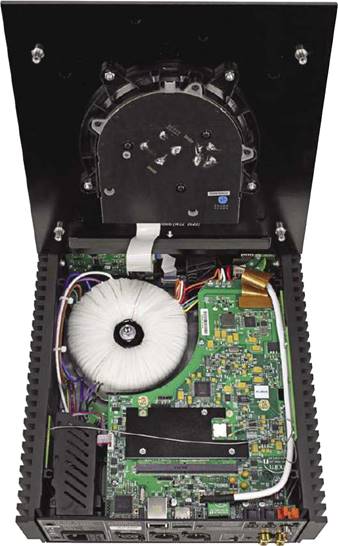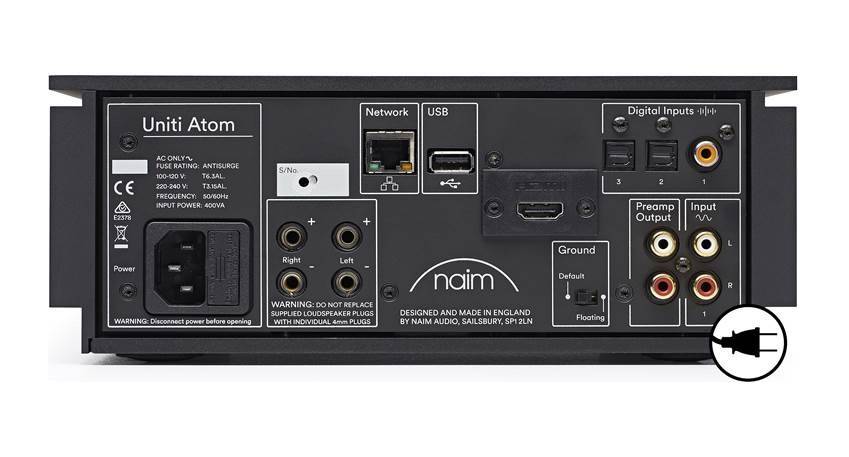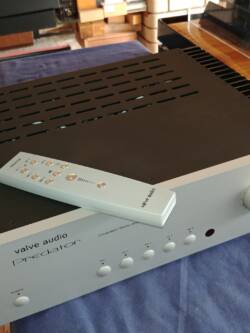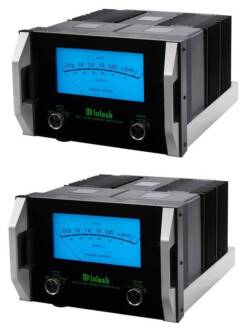Naim Unity Atom Headphone Edition
Original price was: R90,000.00.R34,000.00Current price is: R34,000.00.

- Audio Format :
WAV – up to 32bits/384kHz
FLAC and AIFF – up to 24bit/384kHz
ALAC (Apple Lossless) – up to 24bit/384kHz
MP3 – up to 48kHz, 320kbit (16 bit)
AAC – up to 48kHz, 320kbit (16 bit)
OGG and WMA – up to 48kHz (16 bit)
DSD – 64 and 128Fs
M4A – up to 48kHz, 320kbit (16 bit)
Note: Gapless playback supported on all formats. - Product type : all in one player
- Supported sampling rates :
USB : 44.1kHz – 384kHz (16 to 24bit)
S/PDIF : 32kHz – 192kHz (up to 24bit) - Analogue inputs :
1 x Stereo RCA pair - Analogue outputs :
1 x Stereo XLR Preamp output
1 x RCA sub/pre output - Digital inputs :
2 x optical TOSLink (up to 24bit/96kHz)
1 x coaxial RCA (up to 24bit/192kHz, DoP 64Fs) - Headphone outputs : 1 x jack 6,35 mm, 1 x Pentaconn 4.4 mm (balanced), 1 x XLR 4-pins (symmetrical)
- Power Output :
1.5W RMS per channel into 16 ohms.
Suitable for headphones from 16 ohms
and upwards - USB ports : 2x USB 2.0 (Type A connector)
- WiFi :
Wi-Fi (802.11 b/g/n/ac) with internal antenna, integrated into the heat sink (patent GB2524815B) - Internet Radio Formats : Windows Media-formatted content, MP3, ACC, Ogg Vorbis streams and MMS
- Multi-Room :
Multiroom streaming and its “Party Mode” (sync up to six Naim streamers), and control them via the “Focal & Naim” application - Network : Ethernet (10/100Mbps), Wi-Fi (802.11a/b/g/n/ac), BLE v4.2
- Storage :
Store up to 20,000 tracks to a local USB connected storage device and serve to a network-connected player.
External portable SSD – max. 1TB
USB sticks – max. 128 GB. - Streaming : Apple AirPlay 2, Bluetooth, Chromecast, Internet Radio, Qobuz, Roon Ready, Spotify®Connect, TIDAL, UPnP™
Description
Naim Audio Atom Uniti HE Streaming Headphone Amplifier

The Naim Uniti Atom Headphone Edition is one of the most ingenious products I’ve encountered in a long time. What makes it so? Perhaps the best way to explain is to look at its antecedent, the non-HE Uniti Atom, and see what changed. (The HE officially stands for “Headphone Edition,” but as you’ll see it could justifiably denote High End.)
Some readers may be familiar with Naim’s immensely popular Uniti Atom. The device, aesthetically the HE version’s doppelgänger, is a sleek, compact, high-grade 40Wpc integrated amp with a built-in streamer and DAC. Just add speakers (and any additional sources), and you’ve got a system.
Given all that functionality in a small package and a $3799 price point, the Uniti Atom presented Naim with a design challenge: how to keep costs down, conserve space, and end up with something that sounds really good. Since Naim conceived the Uniti Atom as an integrated amplifier intended to drive passive speakers, the company put the largest chunk of the parts-and-space budget into the power amp. As for the streaming module, Naim had two options: use the same streamer found in all the company’s products, including its flagship models; or develop a smaller, less-expensive version. Ultimately, Naim decided to use the existing module, thereby reaping economies of scale and ensuring the Atom would have excellent streaming performance.
One area where downscaling did make sense was the linestage. Since the preamp would never stand alone, nor drive any amp other than the Atom’s internal unit, Naim opted for a pared-down section designed specifically to work well within that limited context. Yet Naim wanted the Uniti Atom to be versatile, so it endowed the unit with a generous assortment of both digital and analog ports.

Finally, the company wrapped the product in a striking package, with a front-panel color display and an oversized, backlit volume control that glows brighter when touched. Naim also developed a highly intuitive app to enable users to control everything from any mobile device. Those cosmetic and ergonomic flourishes also cost money. The few bucks left over went toward a necessarily basic headphone amp.
Naim apparently made all the right choices, as attested by the Uniti Atom’s sales success. The model serves its intended audience—audiophiles seeking an affordable, space-conscious system center—very well. But there was another market on which the company had designs: young music lovers, especially those who might someday become full-fledged audiophiles. This group grew up initially listening to music through earbuds, graduating to headphones—sometimes very expensive headphones.
Naim recognized that, for this cohort, the Uniti Atom had the right packaging and UI, but the wrong priorities. Having a streamer as the primary source still made sense, but the headphone listening experience had to be paramount. With this in mind, the company conceived the Uniti Atom Headphone Edition, which I’ll refer to as the HE going forward.To build it, Naim carried over the non-HE’s streamer, DAC, sexy styling, and intuitive UI, while ditching the now-superfluous power amp. Designers then deployed the newly freed-up space and budget toward a beefy headphone amp and a significantly upgraded linestage. The rationale for the former is obvious. The thinking behind the new linestage is less immediately apparent, but it’s at the root of why the HE is such a canny concept.
Growth Path
Naim could have settled for a Uniti Atom HE that perfectly served the present needs of music lovers (and privacy-seeking audiophiles). However, to its credit, the company wanted the HE to be more. Specifically, it wanted the new model to provide its young buyers with a path toward a full-blown, high-end system. That’s where the new linestage comes in. Here’s how it works.
Even in its initial use case of driving headphones, the Uniti Atom HE is far more than a headphone amp. After all, headphone amps require something to amplify. The HE’s built-in streamer delivers material from Qobuz, Tidal, and Spotify. In this way, like the non-HE Uniti Atom, the HE is a self-contained music system. Only this time, instead of “just add speakers,” it’s “just add headphones.”
At some point, though, these young headphone listeners may develop a yen for the freedom, superior bass, and shared experience afforded by honest-to-gosh loudspeakers. Given likely space and budgetary constraints, these budding audiophiles will gravitate toward the current wave of cute, smallish, powered speakers, such as those from KEF, GoldenEar, and many others. In this scenario, a high-quality linestage and volume control become essential. The Uniti Atom HE has those. Therefore, to make this transition from headphone listening to speaker listening, one need only add powered speakers. The HE was, in effect, awaiting this moment.
Looking even further down the road, these maturing listeners may well have the desire, space, and means for larger speakers driven by a potent power amp. At this point, do they finally have to forsake the Uniti Atom HE? Not at all. It was precisely with this scenario in mind that Naim endowed the Uniti Atom HE with not only the over-engineered linestage but also with both single-ended and balanced analog outputs.
Notice that throughout this evolution, HE owners never lose any of their investment, never have to learn a new interface, never have to disturb any additional sources they’ve added along the way. Further, they retain the suave looks, friendly form factor, and slick, app-based UI. Of course, the concept only succeeds if the HE excels sonically in its various usage scenarios. I evaluated two of them: the HE as a standalone streaming headphone amp, and the HE as the control point/linestage/streamer in a reference-grade system.
The Uniti Atom Headphone Edition as a Streaming Headphone Amp
To assess the HE as a streaming headphone amp, I set it on my desk next to my reference headphone rig: a Moon 230HAD headphone amp driven by an HP Windows 10 desktop PC running Roon, Tidal, and Qobuz. Headphones were a pair of the excellent Focal Stellia ($3000, see separate review in this issue).
Setting up the Uniti Atom HE was a snap. Naim is not some Johnny-come-lately to the world of wireless components controlled by phone- or tablet-based apps. The company has been doing that—and multi-room as well—for a long time. As a result, they’ve got this down. No glitches, bugs, false starts, reboots, or any of the other maladies that plague many high-end components trying to elbow their way into the personal audio space. I simply downloaded the Naim app, followed the instructions, and the app itself set up the HE for my Wi-Fi network and streaming accounts. In minutes, I was ready to listen.
But first I had to decide which headphone output to use. The Uniti Atom HE presents owners with three options. The first is a standard ¼” TRX jack, located on the front panel right beside the display screen. Right above it is a Pentaconn jack. Around back, there’s an XLR jack for balanced headphone connections. The Stellia cans come with cabling for both TRX and XLR jacks, which made the comparison a snap.
When I first heard the Stellia/Uniti Atom HE combo at the latter’s U.S. introduction in Houston, the Stellias were connected to the balanced output. At the time, I found that setup formidable, but I had no way to compare it against the TRX option. Now I could, and in doing so a definite preference emerged for the front-panel TRX jack. That interface offered more fleshed-out tonality, as well as multiple other areas of superiority.
That settled, I started my listening with something fun: “Sun King” from the remastered Beatles Abbey Road. Before I knew it, I had already played deep into the Side 2 medley, seemingly powerless to press “Stop” on my phone. I was able to hear everything Giles Martin had brought out of the shadows, follow each musical line, and appreciate the tapestry of the whole. The rhythmic drive was irresistible. All along, the considerate Uniti Atom HE displayed the album cover on its front-panel screen.
Like all Naim components I’ve experienced, the Uniti Atom HE gives a “bottom up” presentation that’s tonally rich (though never bloated), full, and seductive in its lushness. There’s a low-end solidity that allows for unswerving propulsion when the music demands it. That’s not to imply that there is no upper-end extension, for there most certainly is—with the right accessories. (See Sidebar.)
Still thoroughly enjoying Abbey Road, I moved on to “Come Together” (Ringo’s favorite Beatles track, by the way). On my reference Moon Audio amp, what you notice most is that the song crackles with liveliness. But with the Naim what comes through most prominently is the track’s unstoppable force. In the song’s last section, the bass line, the beat, and the keyboards all converge to create a sonic foundation for John’s vocals and George’s crisp guitar licks. Harrison once said that, at the center of it all, the Beatles were just “a very tight little band.” On this track, through the Uniti Atom HE, you can hear what he means.
The Naim also pulls up all kinds of detail; indeed, far more than the PC/Moon combo. For instance, the London Grammar track “Hey Now,” as played by the Naim, captures all the artful echoes and decays the group placed in the song. On Mingus’ complex Ah Um, the HE demonstrates dynamic range and resolution that are superior to that of the Moon. In sum, as a streaming headphone amp, the Naim Uniti Atom HE is stellar.
As a Streaming Control Center
It was time to test the HE in its ultimate use case: as a reference-system control center. To do so, I tucked the unit under my arm and walked it downstairs to my primary listening space. The current nerve center of my reference system is a fully loaded CH Precision I1 universal amp. As configured, the I1 has all the functionality of the Naim, as well as a power amp. The system also includes a Goldmund turntable and a Bryston BCD-3, which can be used as a CD transport (via its digital output) or a CD player (through its analog output).
For the test bed, I connected the Naim’s balanced outputs to the CH Precision’s analog inputs set to bypass mode. That meant the Naim was serving as the system’s linestage and the CH was purely its power amp. Then, by simply switching the I1’s source from, say, my Roon Nucleus+ streamer to the Naim in streamer mode, I could make direct comparisons. I was fortunate to have the ever-so-revealing Stenheim ALUMINE 3 speakers in my system at the time.
Given the 10x price differential between the Roon and the all-CH setups, I expected the comparison to expose many limitations of the Uniti Atom HE. That didn’t happen. In fact, I was shocked that the two sounded so similar. The CH had slightly fuller timbres, and its dynamics (a CH Precision hallmark) were subtly more expressive. And…that’s about it. Factors such as imaging, detail resolution, and bass were a dead heat.
Importantly, as a linestage the Naim never forfeited the fabric that gives a particular piece of music its individuality. From the wafting-on-a-breeze gentleness of George Harrison’s “I’d Have You Anytime” (All Things Must Pass 50th Anniversary) to the quirky immediacy of Jean-Christophe Gayot’s take on Stravinsky’s L’Histoire du soldat (Harmonia Mundi), the Naim preserved each recording’s unique gestalt.
As previously mentioned, the Uniti Atom HE is also equipped to serve as a DAC and/or an analog linestage. I tested it in both modes, and the results were nothing short of amazing. Using the Bryston BCD-3 as a transport, I ran its SPDIF output into the Naim, which converted it to analog and sent it along to the I1’s power amp section. The Naim proved a smidgen less open at the very top than the I1’s own DAC, and a little less refined overall. Yet both differences would be hard to spot without a direct comparison.
Similarly, when acting as a pure analog linestage—this time using the Bryston’s analog outputs (and its excellent BDA-3 internal DAC)—the Naim and I1 were incredibly close. Indeed, in this scenario I could find no significant drawbacks to the Naim. While its other functions are all excellent, the Uniti Atom HE’s analog linestage is nothing short of reference class. I’m not saying the HE and the I1 in analog mode sound the same. The Naim is a shade darker in its tonal colors. But that’s a matter of preference, not superiority.
The bottom line is this: If you buy the HE with a mind to use it as a self-contained streaming headphone app, bon appétit. You’ll be delighted with its style, build, interface, and sound. And if you buy it with a mind to eventually migrate it to a central role in a full-blown system, buon appetito. You can do so with confidence that the Naim is more than up to that task, as well.
Conclusion
There are any number of quality headphone amps on the market, as well as great streamers. But Naim’s Uniti Atom Headphone Edition stands out for combining the two in a package that delivers style, ergonomics, and superb sound at a very reasonable price. That should prove appealing for both young music lovers and grizzled audiophiles who want to set up a self-contained, compact system for headphone listening in a private space.
But where the HE truly shines is when it’s asked to do more than that. Its excellent internal linestage and volume control allow it to drive the very best powered speakers when called upon to do so. Later, if asked to drive a reference-class power amp while supporting top-shelf digital and analog sources, the HE is capable of doing so at a level within glancing distance of far more expensive gear.
In sum, the Naim Uniti Atom Headphone Edition will get you started down the audiophile road and will take you as far down it as you’d like to go.











